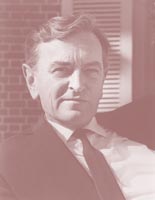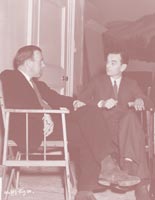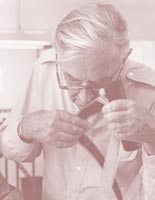Biography
David Lean was born in Croydon on 25 March, 1908. His life in film began at the Lime Grove Studios of the Gaumont-British Picture Corporation, where he worked his way up to become an editor, having discovered an affinity with, and an aptitude for, the cutting process. By 1930 he had become editor of Gaumont Sound News, moving to British Movietone News in 1931. At about this time, Lean was screen-tested, to see if he had any potential as an actor.

The young David Lean
David Lean also began editing low-budget feature films during this period, including Money For Speed, (d. Bernard Vorhaus, 1933) and The Ghost Camera (d. Bernard Vorhaus, 1933). When Lean's final film as a director, A Passage to India (1984) was released, Bernard Vorhaus wrote to congratulate him, recalling the young man who had once worked for him. Lean was soon editing large-budget, prestigious films such as As You Like It (d. Paul Czinner, 1936), Pygmalion (d. Anthony Asquith, 1938) and Major Barbara (d. Gabriel Pascal, 1940).
By 1941, David Lean was a highly-respected film editor, but the right opportunity to move into direction had not yet presented itself, until he agreed to co-direct In Which We Serve (1942) with Noël Coward. The film told the story of H M S Torrin, a destroyer which is sunk during World War Two. As the crew await rescue - or death - they remember, in flashback, their families, and the events leading up to the moment the ship was hit by enemy action.
As Coward, who had written the script, was also playing the leading role, Lean effectively directed the film, which became a critical and popular success. Encouraged by Coward, who was delighted with the film, Lean formed a production company, Cineguild, with the film's producer, Anthony Havelock-Allan, and cinematographer Ronald Neame. Cineguild's first three films were all adaptations of Coward plays. Coward was a master of dialogue but Lean was more interested in film as a visual medium. The first venture was This Happy Breed (1944), which, although set almost entirely in the house of the lower middle-class Gibbons family in the period between the two World Wars, allowed Lean to experiment with technique, including the brilliant opening sequence which begins with an aerial view of the River Thames and closes in on the front door of the Gibbons' house.

David Lean with early collaborator Ronald Neame
Lean was not wholly at ease in the high comedy world of the next venture, Blithe Spirit (1945), but the third film, Brief Encounter (1945), announced Lean as a true poet of the cinema. Small in scale, the film established Lean's distinctive style, with its atmospheric lighting, its use of expressive and romantic music, and its theme of duty and convention versus romantic self-expression.
Cineguild turned to Charles Dickens for its next two films, beginning Lean's long collaboration with the actor Alec Guinness. Great Expectations (1946) opened with a wordless sequence which immediately summoned up the desolate world of the Kent marshes and Pip's isolation within it. Both films showed to the full Lean's increasing mastery of lighting, framing and use of sound. Oliver Twist (1948) again featured an atmospheric opening sequence, as Oliver's pregnant mother battles against the storm to reach the workhouse. Both adaptations successfully conveyed the grotesquery, heartlessness and brutality in Dickens' novels.
Lean's final two films for Cineguild, before the company was wound up, starred his third wife, Ann Todd. Neither were well-received by critics or audiences, although both contain some impressive sequences. Technically assured, they lack the emotional intensity of Lean's earlier work. The Passionate Friends (1949) was based on a novel by H.G.Wells. Madeleine (1950), set in Victorian Glasgow, was the true story of Madeleine Smith, who had been accused of poisoning her French lover.
Problems at the Rank Organisation drove Lean to make his next two films for Alexander Korda. The Sound Barrier (1952), the story of a pilot who breaks the sound barrier, again starred Ann Todd and was a success. The story was altogether more 'epic' in scale than Lean's previous work, and looked forward to the films he was to make in the second half of his career.
Hobson's Choice (1954) was a wonderfully filmic adaptation of a stage comedy by Harold Brighouse and reunited Lean with actor John Mills, with whom he made five films (Mills also featured in The Ghost Camera). The performances are superb and the set pieces are beautifully crafted. His next picture was Summer Madness/Summertime (1955), a co-production with United Artists starring Katharine Hepburn. It was shot entirely on location in Venice and proved to be a turning point in Lean's career. He would, henceforth, forsake the studio-bound set.

David Lean at the British Film Institute in 1982
Lean next planned to film The Wind Cannot Read but disagreed with Korda about the script. Korda then died in January 1956, Lean entered into discussions with American producer Sam Spiegel regarding The Bridge on the River Kwai and work on the film was abandoned. The rights were subsequently sold to Rank who made the film in 1958, with Ralph Thomas as director.
The Bridge on the River Kwai (1957) was filmed in the jungles of Ceylon and reunited Lean with Alec Guinness. The film won Lean his first Oscar and it enjoyed huge critical and popular success. The central relationship between Colonel Nicholson (Guinness) and his Japanese counterpart Colonel Saito was played out against a setting of epic scale. The theme tune, 'Colonel Bogey', was played at Lean's memorial service at St. Paul's Cathedral.
Lean's next film was his masterpiece. Lawrence of Arabia (1962), produced by Sam Spiegel, had spectacular action and scenery, high drama, a great adventure story, and a charismatic, deeply flawed hero. Filming in the Jordanian desert, Spain and Morocco, Lean worked for the first time with ace cinematographer Freddie Young, achieving sequences of incomparable beauty and poetry. It was also Lean's first collaboration with writer Robert Bolt and film composer Maurice Jarre. The film was impeccably cast all the way down the line, and won seven Oscars. But the Lean-Spiegel partnership did not survive the tensions generated during production and Carlo Ponti produced Lean's next film, an adaptation of Boris Pasternak's Nobel Prize-winning novel, Doctor Zhivago (1965). Robert Bolt wrote the script and Omar Sharif, who had played Sherif Ali in Lawrence, took the title role. Alec Guinness appeared in a small role as Zhivago's brother. The film won five Oscars and became a great box office success. It was, again, a film of visual splendour, especially the spectacular crowd scenes, the train journey from Moscow and the unforgettable 'house of ice'.
Lean's next project with Robert Bolt was an updated version of Flaubert's Madame Bovary. Ryan's Daughter (1970) was set in a remote Irish village after the Easter Rising of 1916. As spectacularly beautiful as Lean's two previous films, and boasting some fine performances, the film was badly received. Lean was hurt by the reaction and did not make another feature film for fourteen years, although he planned, with Robert Bolt, an epic two-part dramatisation of the Bounty mutiny story. He also made a documentary for New Zealand television, Lost and Found: The Story of an Anchor (1978), about the salvage of an anchor from one of Captain Cook's ships, discovered whilst location scouting for the Bounty films.
In 1981, David Lean was approached to direct a film version of E.M. Forster's novel A Passage to India (1984). He wrote his own script for the film. Alec Guinness played his last role for Lean, Professor Godbole. The film was a critical success, winning two Oscars, and Lean was knighted the year of its release. The previous year he had been made one of the first Fellows of the British Film Institute and in 1990 he received a Lifetime Achievement Award from the American Film Institute. David Lean died of pneumonia on 16 April 1991, while preparing to film his adaptation of Joseph Conrad's novel Nostromo.
David Lean became associated with the epic, but the films of the first half of his career were modest and domestic in scale, and photographed in black and white, apart from This Happy Breed and Blithe Spirit. He worked with the same collaborators over a number of years - his Cineguild colleagues Ronald Neame and Anthony Havelock-Allan, the cinematographers Guy Green and Freddie Young, associate producer Norman Spencer, designer John Box, the writer Robert Bolt, and the actors John Mills, Alec Guinness, Robert Newton, Kay Walsh, Ann Todd and Celia Johnson. Some motifs occur and re-occur in his work - trains, atmospheric night scenes, the use of a romantic music score. He is a great poet of the cinema, having few equals in telling a story, evoking an atmosphere or describing an emotion through pictures.
Janet Moat